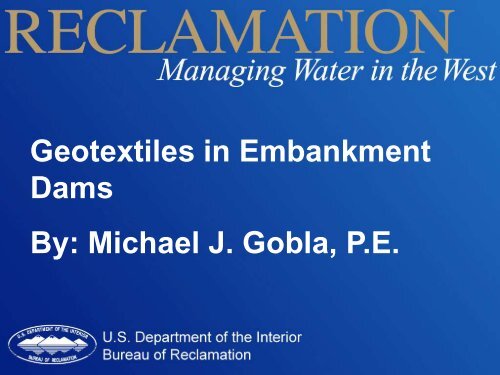Geotextiles in Embankment Dams By - Association of State Dam ...
Geotextiles in Embankment Dams By - Association of State Dam ...
Geotextiles in Embankment Dams By - Association of State Dam ...
You also want an ePaper? Increase the reach of your titles
YUMPU automatically turns print PDFs into web optimized ePapers that Google loves.
<strong>Geotextiles</strong> <strong>in</strong> <strong>Embankment</strong><strong><strong>Dam</strong>s</strong><strong>By</strong>: Michael J. Gobla, P.E.
Purpose <strong>of</strong> this PresentationDiscuss controversial aspects regard<strong>in</strong>ggeotextile use <strong>in</strong> filtration and dra<strong>in</strong>agePresent both sides <strong>of</strong> the issueReview a few case historiesStimulate a discussion <strong>of</strong> the subject
Orig<strong>in</strong>al study for FEMA publishedas a Compact Disc <strong>in</strong> 2009:<strong>Geotextiles</strong> <strong>in</strong> <strong>Embankment</strong> <strong><strong>Dam</strong>s</strong>Status Report on the Use <strong>of</strong> <strong>Geotextiles</strong> <strong>in</strong><strong>Embankment</strong> <strong>Dam</strong> Construciton and RehabilitationFEMA P-730 CD/ January 2009
• Fund<strong>in</strong>g by FEMA and Bureau <strong>of</strong> Reclamation– Team Member Organizations contributed labor.• Team Members:Michael Gobla, P.E. – Bureau <strong>of</strong> ReclamationDave Paul, P.E. – Bureau <strong>of</strong> ReclamationJay Swihart, P.E. – Bureau <strong>of</strong> ReclamationDouglas Crum, P.E. – Corps <strong>of</strong> Eng<strong>in</strong>eersSteve Re<strong>in</strong>sch, P.E. – Natural Resources Conservation ServiceRon Frobel, P.E. – Private Sector ConsultantJohn Falk, P.E. – <strong>State</strong> <strong>of</strong> OregonJerald LaVassar, P.E. – <strong>State</strong> <strong>of</strong> Wash<strong>in</strong>gton
Policy:It is the policy <strong>of</strong> the National <strong>Dam</strong> SafetyReview Board that geotextiles should not beused <strong>in</strong> locations that are critical to the safety<strong>of</strong> the dam.
Types <strong>of</strong><strong>Geotextiles</strong>• Woven• Non-woven Needle Punched• Non-woven Heat Set• Knitted• 95% <strong>of</strong> new geotextiles aremade from polypropylene
Woven <strong>Geotextiles</strong>• Mon<strong>of</strong>ilament• Slit film• Multifilament• Used <strong>in</strong> dams for filtration,re<strong>in</strong>forcement, separationand erosion control.
Nonwoven Needlepunched <strong>Geotextiles</strong>• Staple fiber• Cont<strong>in</strong>uous filament• Used <strong>in</strong> dams for protection,filtration, dra<strong>in</strong>age, separation,re<strong>in</strong>forcement, erosion control
NonWoven Heat Set <strong>Geotextiles</strong>• Fibers are fused together by heat• Produces th<strong>in</strong> fabrics used to filterf<strong>in</strong>e-gra<strong>in</strong>ed soils• Wick dra<strong>in</strong>s are a typical application
Knitted GeotextileUsed as a filter wrapp<strong>in</strong>garound dra<strong>in</strong>age pipe
Geocomposites• Geotextile bonded to ageomembrane• Geotextile bonded to geonet• Geotextile wrapp<strong>in</strong>g adra<strong>in</strong>age core• Two or more geotextilesbonded together
An October 2000 FEMA Research NeedsWorkshop Concluded:“ The current practice for the use <strong>of</strong> geotextiles <strong>in</strong> seepagecollection systems varies widely among organizations andpractitioners <strong>in</strong>volved <strong>in</strong> dam eng<strong>in</strong>eer<strong>in</strong>g.”• <strong>Geotextiles</strong> should not be used <strong>in</strong> locations that are bothcritical to safety and <strong>in</strong>accessible for replacement.• <strong>Geotextiles</strong> can be used <strong>in</strong> locations that are critical for safetybut accessible for replacement. However, the eng<strong>in</strong>eer mustassess the potential hazard posed by failure <strong>of</strong> the geotextileand the time available to respond and repair or replace thegeotextile.• This position may change <strong>in</strong> the future based on development<strong>of</strong> data on long-term, <strong>in</strong>-place performance <strong>of</strong> geotextiles <strong>in</strong>dam applications.”
Geotextile Functions <strong>in</strong> <strong>Embankment</strong> <strong><strong>Dam</strong>s</strong>• Internal filter (not accepted practice)• Internal dra<strong>in</strong> (not accepted practice)• Toe dra<strong>in</strong> filter (acceptability depends on design)• Separation between embankment zones.• Slope re<strong>in</strong>forcement• Protective cushion and dra<strong>in</strong>age layer for a membrane• Erosion control / filter underneath riprap
Geotextile Functions <strong>in</strong><strong>Embankment</strong> <strong><strong>Dam</strong>s</strong>
Controversial <strong>Embankment</strong> Applications• Filter• Dra<strong>in</strong>• Crack Stopper• Deeply buried• Non-redundant feature• Critical to dam safety
Toe Dra<strong>in</strong> EconomyShielded trench<strong>in</strong>gmach<strong>in</strong>e andgeotextile filterreduced excavationand granular filterneeds by 90 %.
Major IssueShould geotextiles be used<strong>in</strong> embankment filtration asthe sole means <strong>of</strong> defenseaga<strong>in</strong>st <strong>in</strong>ternal erosion?
Where Has it Been Done?1970 – 17 meter high Valcross <strong>Dam</strong>, FranceDr. J. P. Giroud designed a 9 oz geotextile filterwrapped around a gravel dra<strong>in</strong>. <strong>Dam</strong> is ahomogeneous silty sand embankment.
Valcros <strong>Dam</strong>, France – 1970 17 m Still Function<strong>in</strong>gBrugnens <strong>Dam</strong>, France – 1973Formitz <strong>Dam</strong>, Germany – 1975 (86 meters high)Frauenau <strong>Dam</strong>, Germany – 1980Schonstadt <strong>Dam</strong>, Germany – 1982Chateauvieux <strong>Dam</strong>, France – 1983La Parade <strong>Dam</strong>, France – 1987Reeves Lake <strong>Dam</strong>, USA – 1990 (10.7 meters high)Mafeteng <strong>Dam</strong>, South Africa – 1993Teppe Rosse <strong>Dam</strong>, Corsica - 1995Lavaud-Gelade <strong>Dam</strong>, France – 1996Dzoumogne <strong>Dam</strong>, Mayotte – 2000 (24.5 meters high)Samira <strong>Dam</strong>, Niger – 2001Olmito-Garcias No. 2 <strong>Dam</strong>, USA – 2002 (6.4 meters high)Red Willow <strong>Dam</strong>, USA – 2012 (49 meters high)
2001 – 18 meter highSamira <strong>Dam</strong>, NigerA composite geotextileAOS 0.1 wrapped asand dra<strong>in</strong> andhorizontal blanket t<strong>of</strong>ilter a f<strong>in</strong>e lateriticsoil
How Is It Accomplished?• Many use a 2-layer geotextile• Meet permeability criteria• Meet clogg<strong>in</strong>g criteria, 1” gravel• Filtration test<strong>in</strong>g with site soils• Design for load<strong>in</strong>g• Strict QC/QA dur<strong>in</strong>g construction
Advocates View:• <strong>Geotextiles</strong> filters cost less than processed granularfilters• Geotextile filters are lightweight, easy to transport tothe work site.• Installation is simple.• Inspection <strong>of</strong> subgrade, deployment, seam<strong>in</strong>g, andcover<strong>in</strong>g can be performed visually.• Geotextile filters will act as crack stoppers becausethey have tensile strength and will span across anopen crack• Multi-layer products provide required survivability.
Traditional View:• <strong>Geotextiles</strong> are prone to <strong>in</strong>stallation damage• There is no way to detect construction damage• <strong>Geotextiles</strong> are prone to clogg<strong>in</strong>g• <strong>Geotextiles</strong> will not act as a crack stopper• <strong>Geotextiles</strong> have an unknown service life• Granular filters have an excellent track record• Stay with what worksReality is somewhere <strong>in</strong>between these oppos<strong>in</strong>gviews
Recent Geotextile Trends <strong>in</strong> the US:Use as a separator between downstream side <strong>of</strong> agravel dra<strong>in</strong> and the downstream shell <strong>of</strong> a dam isan accepted application.NRCS with special approval is us<strong>in</strong>g geotextiles torepair cracked embankments. Although it serves asa primary filter/crack stopper these are normally dryflood detention embankments where there is littlerisk <strong>of</strong> clogg<strong>in</strong>g the filter.
Red Willow <strong>Dam</strong> Repair BOR 2012• Geocomposite dra<strong>in</strong> as primary filter and dra<strong>in</strong>, f<strong>in</strong>esand and coarse sand downstream <strong>of</strong> this. It is a 16oz geotextile on a triaxial geogrid with a 6 ozgeotextile on top. Design required special permissionand much debate over clogg<strong>in</strong>g.
Next Steps To Acceptance As Filters• <strong>Geotextiles</strong> as filters can provide sav<strong>in</strong>gs and allowfor more timely dam repairs. They must be usedwisely.• A vett<strong>in</strong>g process and strict standards are needed forthis type <strong>of</strong> application.• ICOLD is try<strong>in</strong>g to revive the committee to prepare anupdate <strong>of</strong> their Bullet<strong>in</strong> 55 “ <strong>Geotextiles</strong> as filters andtransitions <strong>in</strong> fill dams.
Discussion
















